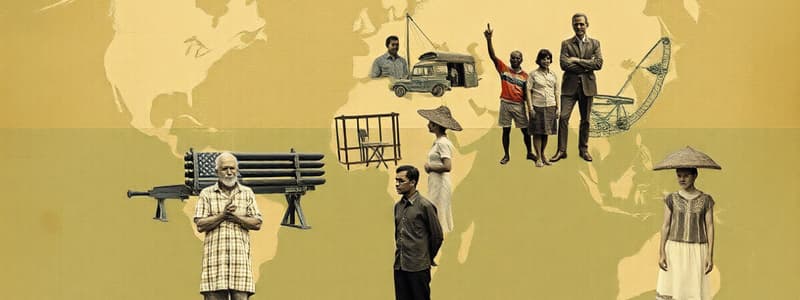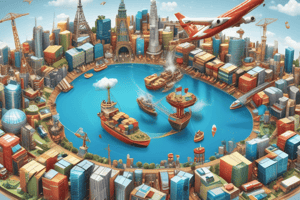Podcast
Questions and Answers
What is a key difference between a value chain and a supply chain?
What is a key difference between a value chain and a supply chain?
- There is no significant difference between the terms; they are often used interchangeably.
- Supply chains are concerned with international trade, whereas value chains are limited to local production.
- Value chains focus solely on cost reduction, while supply chains prioritize quality.
- Value chains encompass all activities that add value, including design and marketing, while supply chains primarily focus on production and logistics. (correct)
Which factor has NOT significantly enabled the rise of global value chains?
Which factor has NOT significantly enabled the rise of global value chains?
- Higher trade costs (correct)
- Increased labor mobility
- Lower costs of trade
- Decreased communication costs
What is the primary role of the International Labour Organization (ILO) in global supply chains?
What is the primary role of the International Labour Organization (ILO) in global supply chains?
- To enforce trade agreements between nations.
- To set and oversee core labor standards. (correct)
- To promote free market practices in developing countries.
- To provide financial aid to corporations operating in international markets.
Which of the following rights are encompassed by the ILO's core labor standards?
Which of the following rights are encompassed by the ILO's core labor standards?
What is a common argument made by proponents of sweatshop labor?
What is a common argument made by proponents of sweatshop labor?
What is the main counterargument used by opponents of sweatshop labor?
What is the main counterargument used by opponents of sweatshop labor?
What is the meaning of Multi-Stakeholder Initiatives (MSIs) in the context of addressing labor rights violations?
What is the meaning of Multi-Stakeholder Initiatives (MSIs) in the context of addressing labor rights violations?
Which level of regulation involves corporate social responsibility (CSR) policies and codes of conduct?
Which level of regulation involves corporate social responsibility (CSR) policies and codes of conduct?
What characterizes the Anthropocene era?
What characterizes the Anthropocene era?
How can businesses address climate change?
How can businesses address climate change?
What does 'Enterprise Integration' refer to in the context of business approaches to climate change?
What does 'Enterprise Integration' refer to in the context of business approaches to climate change?
What is the purpose of 'Market Transformation' as a business approach to climate change?
What is the purpose of 'Market Transformation' as a business approach to climate change?
How is the insurance sector responding to climate-related disasters?
How is the insurance sector responding to climate-related disasters?
What is meant by the 'Great Acceleration' in the context of environmental impact?
What is meant by the 'Great Acceleration' in the context of environmental impact?
What does the Planetary Boundaries concept highlight?
What does the Planetary Boundaries concept highlight?
In the context of market transformation and sustainability, what does redefining corporate purpose involve?
In the context of market transformation and sustainability, what does redefining corporate purpose involve?
What does the debate over the Government-Market Relationship involve?
What does the debate over the Government-Market Relationship involve?
What is a key characteristic of 'New Business Models' in the context of sustainability?
What is a key characteristic of 'New Business Models' in the context of sustainability?
What does 'Shifting Cultural Values' entail in the context of market transformation and sustainability?
What does 'Shifting Cultural Values' entail in the context of market transformation and sustainability?
What is the primary difference between megatrends and trends?
What is the primary difference between megatrends and trends?
Which of the following is an example of a megatrend?
Which of the following is an example of a megatrend?
What is the focus of Scenario Analysis for 2050?
What is the focus of Scenario Analysis for 2050?
What does 'Scenario 1: Business-as-usual within regulated expansion' entail?
What does 'Scenario 1: Business-as-usual within regulated expansion' entail?
What does 'Scenario 2: Transition to sustainable alternatives' involve?
What does 'Scenario 2: Transition to sustainable alternatives' involve?
Which of the following describes 'Scenario 3: Resource extraction beyond Earth'?
Which of the following describes 'Scenario 3: Resource extraction beyond Earth'?
What factors are identified by a PESTEL Analysis?
What factors are identified by a PESTEL Analysis?
What is the main goal of Impact Mapping?
What is the main goal of Impact Mapping?
Which of the following is NOT a core labor standard as defined by the ILO?
Which of the following is NOT a core labor standard as defined by the ILO?
A company decides to implement a comprehensive CSR program that includes fair wages, safe working conditions, and environmental sustainability initiatives. Which level of addressing labor rights violations does this BEST represent?
A company decides to implement a comprehensive CSR program that includes fair wages, safe working conditions, and environmental sustainability initiatives. Which level of addressing labor rights violations does this BEST represent?
Which scenario BEST illustrates the concept of 'Market Transformation' in addressing climate change?
Which scenario BEST illustrates the concept of 'Market Transformation' in addressing climate change?
A tech company predicts potential disruptions by analyzing the impacts of automation, remote work policies, and changes in consumer preferences. Which of the following tools is it primarily using?
A tech company predicts potential disruptions by analyzing the impacts of automation, remote work policies, and changes in consumer preferences. Which of the following tools is it primarily using?
A mining company is evaluating a long-term investment in a new extraction site. They consider climate change regulations, potential political instability, new technologies for extraction, and evolving social attitudes toward mining. Which tool are they most likely employing?
A mining company is evaluating a long-term investment in a new extraction site. They consider climate change regulations, potential political instability, new technologies for extraction, and evolving social attitudes toward mining. Which tool are they most likely employing?
A city government is trying to understand how self-driving cars will affect their infrastructure, traffic patterns, and public transportation systems in the next 5-10 years. What strategic analysis tool would be most helpful?
A city government is trying to understand how self-driving cars will affect their infrastructure, traffic patterns, and public transportation systems in the next 5-10 years. What strategic analysis tool would be most helpful?
Which of the following International Labour Organization (ILO) conventions specifically aims to address the elimination of child labor?
Which of the following International Labour Organization (ILO) conventions specifically aims to address the elimination of child labor?
An organization monitors global demographic shifts, resource scarcity, and emerging technologies to predict future business opportunities. What are they primarily analyzing?
An organization monitors global demographic shifts, resource scarcity, and emerging technologies to predict future business opportunities. What are they primarily analyzing?
A clothing company sources garments from factories in developing countries. To ensure ethical labor practices, they conduct regular audits, provide training to factory workers, and collaborate with local NGOs. This approach BEST describes:
A clothing company sources garments from factories in developing countries. To ensure ethical labor practices, they conduct regular audits, provide training to factory workers, and collaborate with local NGOs. This approach BEST describes:
According to the material, what are the two main approaches that businesses are taking to address climate change?
According to the material, what are the two main approaches that businesses are taking to address climate change?
Flashcards
Global Value Chains (GVCs)
Global Value Chains (GVCs)
The evolution from local to international production due to globalization.
International Labour Organization (ILO)
International Labour Organization (ILO)
Organization focused on international labor standards and rights.
Core Labor Standards
Core Labor Standards
Fundamental rights at work: freedom of association, no forced labor, no child labor, and no discrimination.
Sweatshop Proponents
Sweatshop Proponents
Signup and view all the flashcards
Sweatshop Opponents
Sweatshop Opponents
Signup and view all the flashcards
Corporate Social Responsibility (CSR)
Corporate Social Responsibility (CSR)
Signup and view all the flashcards
Industry Level Regulation
Industry Level Regulation
Signup and view all the flashcards
Multi-Stakeholder Initiatives (MSIs)
Multi-Stakeholder Initiatives (MSIs)
Signup and view all the flashcards
Government regulations on labor
Government regulations on labor
Signup and view all the flashcards
Anthropocene
Anthropocene
Signup and view all the flashcards
Enterprise Integration
Enterprise Integration
Signup and view all the flashcards
Market Transformation
Market Transformation
Signup and view all the flashcards
Redefining Corporate Purpose
Redefining Corporate Purpose
Signup and view all the flashcards
New Business Models
New Business Models
Signup and view all the flashcards
Shifting Cultural Values
Shifting Cultural Values
Signup and view all the flashcards
Megatrends
Megatrends
Signup and view all the flashcards
Trends
Trends
Signup and view all the flashcards
PESTEL Analysis
PESTEL Analysis
Signup and view all the flashcards
Impact Mapping
Impact Mapping
Signup and view all the flashcards
Study Notes
The Rise of Global Value Chains (GVCs)
- Value chains differ from supply chains
- Historically, production evolved from local to international value chains
- Globalization is enabled by lower costs of trade, communication, and labor mobility
Labor and Human Rights in Global Supply Chains
- The International Labour Organization (ILO) plays a crucial role
- Core Labor Standards include freedom of association, collective bargaining (Conventions No. 87 & 98)
- Core Labor Standards include elimination of forced labor (Conventions No. 29 & 105)
- Core Labor Standards include abolition of child labor (Conventions No. 138 & 182)
- Core Labor Standards include elimination of employment discrimination (Conventions No. 100 & 111)
- Common labor rights violations consists of low wages, forced overtime, unsafe conditions, discrimination
- Sweatshop labor is debated, with proponents arguing it is an economic necessity and opponents citing human dignity violations and exploitation by MNCs
Addressing Labor Rights Violations
- Regulation occurs at different levels
- Companies use corporate social responsibility (CSR) policies and codes of conduct
- Industries use sector-wide agreements and initiatives
- Multi-Stakeholder Initiatives (MSIs) collaborate with NGOs and government bodies
- Governments use national and international regulations while facing enforcement challenges
Climate Change and the Anthropocene
- Global warming is a part of the Anthropocene era
- Businesses contribute to and solve climate change
- Enterprise Integration incorporates sustainability into business-as-usual
- Market Transformation shifts business models to create sustainability
- The insurance sector and risk management respond to climate-related disasters
- Renewable energy companies are growing while fossil fuel companies decline
- The 'Great Acceleration' of environmental impact began in 1950
- Climate change is one of nine critical limits in the Planetary Boundaries concept
Market Transformation and Sustainability
- Redefining Corporate Purpose moves beyond profit to societal welfare
- A debate exists over regulation and free markets regarding the Government-Market Relationship
- New Business Models include circular economy and sustainable production
- Shifting Cultural Values promotes Ethical consumption, responsible leadership
Futures Literacy Activity
- Megatrends are long-term, global changes like climate change and aging population
- Trends are shorter-term, localized developments like the rise of electric vehicles
- Scenario Analysis for 2050
- Scenario 1 involves business-as-usual within regulated expansion
- Scenario 2 involves transition to sustainable alternatives
- Scenario 3 involves resource extraction beyond Earth (e.g., asteroid mining)
- PESTEL Analysis identifies political, economic, social, technological, environmental, and legal drivers
- Impact Mapping predicts future consequences for the environment, society, and economy
Studying That Suits You
Use AI to generate personalized quizzes and flashcards to suit your learning preferences.




